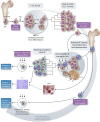The Premalignant Ancestor Cell of t(14;18)+ Lymphoma
- PMID: 34095762
- PMCID: PMC8171372
- DOI: 10.1097/HS9.0000000000000579
The Premalignant Ancestor Cell of t(14;18)+ Lymphoma
Figures


References
-
- Sant M, Allemani C, Tereanu C, et al. ; HAEMACARE Working Group. Incidence of hematologic malignancies in Europe by morphologic subtype: results of the HAEMACARE project. Blood. 2010; 116:3724–3734. - PubMed
-
- Teras LR, DeSantis CE, Cerhan JR, et al. . 2016 US lymphoid malignancy statistics by World Health Organization subtypes. CA Cancer J Clin. 2016; 66:443–459. - PubMed
-
- Dreyling M, Ghielmini M, Rule S, et al. ; ESMO Guidelines Committee. Newly diagnosed and relapsed follicular lymphoma: ESMO Clinical Practice Guidelines for diagnosis, treatment and follow-up. Ann Oncol. 2021; 32:298–308. - PubMed
-
- Arcaini L, Merli M, Passamonti F, et al. . Validation of follicular lymphoma international prognostic index 2 (FLIPI2) score in an independent series of follicular lymphoma patients. Br J Haematol. 2010; 149:455–457. - PubMed
Publication types
LinkOut - more resources
Full Text Sources
Research Materials
